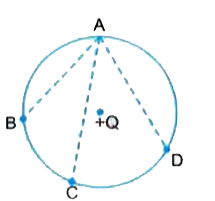In the firgure the charge Q is at the centre of the circle. Work done is maximum when another charge is taken from point P to

K
L
M
N
Step by step video & image solution for In the firgure the charge Q is at the centre of the circle. Work done is maximum when another charge is taken from point P to by Physics experts to help you in doubts & scoring excellent marks in Class 12 exams.
Updated on:21/07/2023Topper's Solved these Questions
- ELECTROSTATICS BOOK - ERRORLESS CHAPTER - ELECTROSTATICS EXERCISE - Ordinary Thinking Objective Questions (Electric Dipole)
38 Videos
- ELECTROSTATICS BOOK - ERRORLESS CHAPTER - ELECTROSTATICS EXERCISE - Ordinary Thinking Objective Questions (Electric Flux and Gauss.s Law)
28 Videos
- ELECTROSTATICS BOOK - ERRORLESS CHAPTER - ELECTROSTATICS EXERCISE - Ordinary Thinking Objective Questions (Electric Flux and Gauss.s Law)
28 Videos
- ELECTRONICSBOOK - ERRORLESS CHAPTER - ELECTRONICSEXERCISE - Selv Evaluation Test
23 Videos
- HEATING AND CHEMICAL EFFECT OF CURRENTBOOK - ERRORLESS CHAPTER - HEATING AND CHEMICAL EFFECT OF CURRENTEXERCISE - Self Evaluation Test
14 Videos
Similar Questions
In the electric field of a point charge (+q) , placed at the centre of a circle , a certain test charge is carried from point A to B, C,D and E Least amount of work is done along the path

View Solutiona. A circle is drawn with center as a charge +q. What is the work done in moving a charge +q from B to C along the circumferebce of the circle ?
B In the above question, if the charge +q is first taken from B to A and then from A to C, on which path is the magnitude of work greater ?
 .
.
View Solution
Knowledge Check
In the electric field of a point charge Q placed at the centre of a circle, as shown in fingure, a certain test charge q0 is carried from point A to B, C B and D. Then the work done
 Ais least along the path AB.Bis least along the path AC.Cis same along all the three paths AB, AC as well as AD and has a finite value.Dis zero for all the three paths.
Ais least along the path AB.Bis least along the path AC.Cis same along all the three paths AB, AC as well as AD and has a finite value.Dis zero for all the three paths.A,B,C are three points as a circle of radius 1cm.These points form the corners an equilateral triangle .A charge 2C is placed at the centre of circle .The work done in carrying a charge of 0.1μc form A to B is
AzeroB18×1011JC1.8×1011JD54×1011JAs per this diagram a point charge +q is placed at the origin O. Work done in taking another point charge −Q from the point A(0,a) to another point B(a,0) along the staight path AB is:
 A(−qQ4πε01a2)√2aBzeroC(qQ4πε01a2)1√2D(qQ4πε01a2)1√2a
A(−qQ4πε01a2)√2aBzeroC(qQ4πε01a2)1√2D(qQ4πε01a2)1√2a
As per this diagram a point charge +q is placed at the origin O. Work done in taking another point charge −Q from the point A(0,a) to another point B(a,0) along the staight path AB is:

View SolutionA dipole of 2μC charges each, consists of the positive charge at the point P (1, -1) and the negative charge is placed at the point Q(-1, 1). The work done in displacing a charge of +1μC from point A(−3,−3) to B (4, 4) is
View SolutionA point positive charge of Q' units is moved round another point positive charge of Q units in circular path. If the radius of the circle r is the work done on the charge Q' in making one complete revolution i-
View SolutionThere is 10 units of charge at the centre of a circle of radius 10m. The work done in moving 1 unit of charge around the circle once is
View SolutionA charge Q is placed at the origin. The electric potential due to this charge at a given point in space is v. The work done by an external force in bringing another charge q from infinity up to the point is
View Solution
